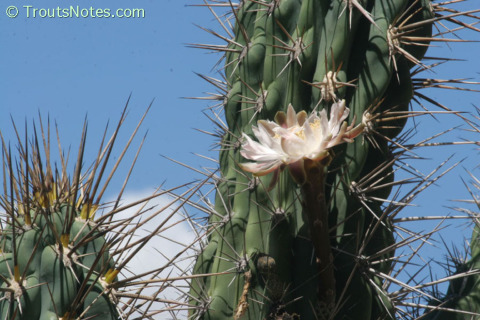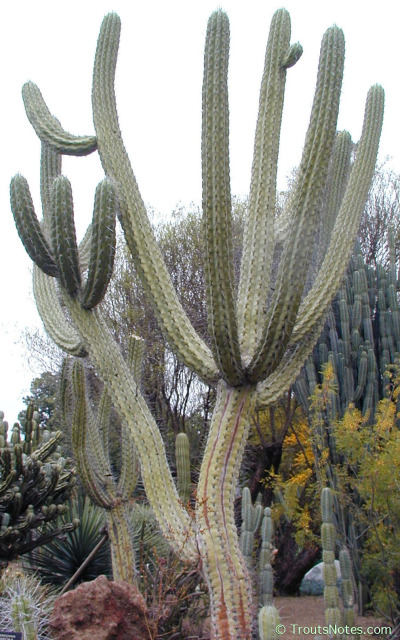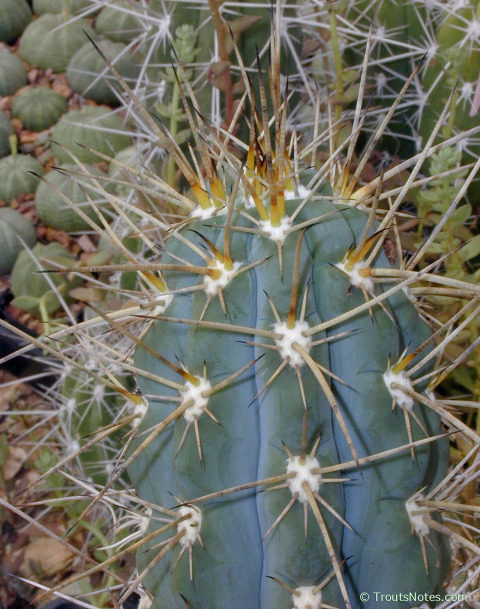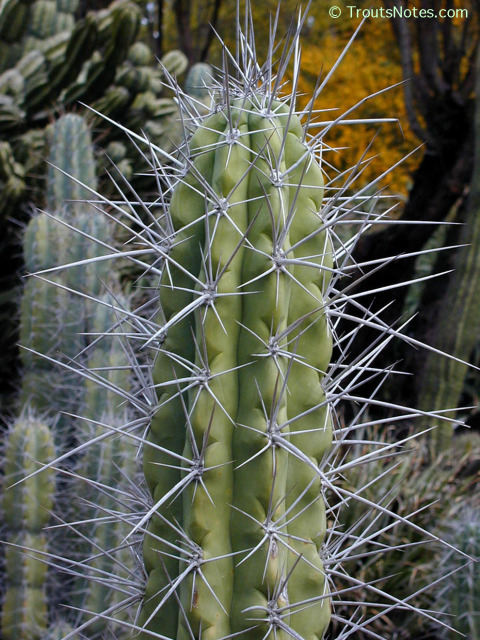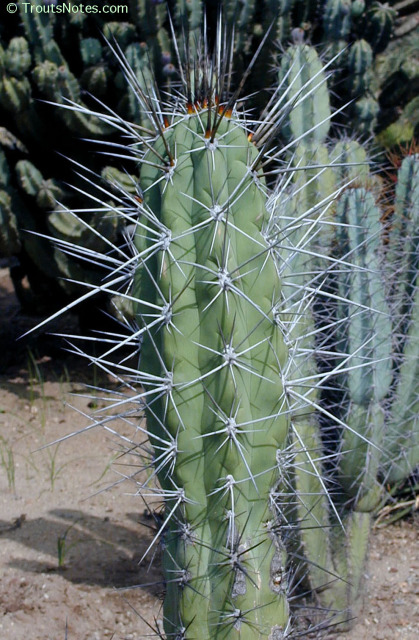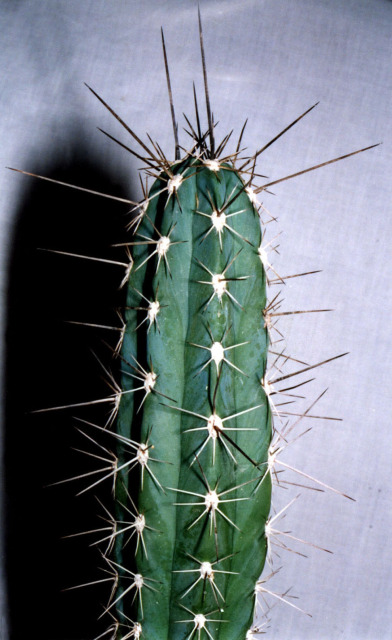Stetsonia coryne (Salm-Dyck) Britton & Rose
Joseph Franz Maria Anton Hubert Ignatz Fürst zu Salm-Reifferscheid-Dyck (1850) Cacteae in Horto Dyckensi Cultae, anno 1849, 205, as Cereus coryne.
Nathaniel Lord Britton & Joseph Nelson Rose (1920) The Cactaceae, 2: 64, as Stetsonia coryne.
Mescaline has been reported to be present in low concentrations.
Common names: “Argentine Toothpick” Anderson 1998
Etymology: Coryne is derived from the Greek word for “Club”.
Distribution & occurrence: Northwestern Argentina
There is also a variety; Stetsonia coryne var. procera which occurs in mountainous terrain in Dept. Tarija, borders of the Provinces Gran Chaco and O’Connor and Palos Blancos in Bolivia. It has a scattered distribution.
“C. caule erecto subclavato glaucescenti-perviride 8 angulato, costis crassis superne tumido obrepandis, pulvillis subconfertis latis orbiculatis tomento lanuginoso albo instructis, aculeis exterioribus radianter patentibus, inferioribus 5 albidis (infimo breviore) superioribus 2-3 longioribus cum centrali solitario validissimo.
Caulis hueusque poll. 8-9 altus, diametro fere bipolicari, vix clavatus. Pulvilli lin. 6 distantes, lati, tomento lanuginoso, albidissimo muniti. Aculei 3 superi (intermedio saepe deficiente) lin. 9 longi, cum centrali patentissimo sesquipollicari nigri. “
p. 205, Salm-Dyck (1850)
(Describing a plant from the Berlin Botanical Gardens.)
Large and massive tree-like plant which can reach 5 to 8 meters. (& up to 10 feet across) Reti describes them as 3 meters tall and forming literal forests of cacti in the Cordoba Province of northwestern Argentina.
It has a short trunk up to 40 cm in diameter with many grey-blue branches (over 100). The branches have 8 to 9 ribs and can reach 6 cm in length.
7-9 spines, the longest being 5 cm (Can exceed 6 inches according to Anderson 1998). Spines are brownish yellow soon becoming white with black tips.
It bears white flowers; 12 to 15 cm.
Anderson 1998: 111 (nice picture of cultivated plant) and Britton & Rose 1920 2: 64-65. (Has an impressive photograph of an adult) and Backeberg 1977: 464. Photo on page 111 of Anderson 1998
Plants in cultivation are normally fairly small, single and rather
club shaped unless someplace they can be planted in the ground. The longest spine is black tipped and forms a beautiful contrast to the often dark bluish green skin.
var. procera is said to grow to 10 meters, with a skin that is milky green at first and has pink petals on the flowers. Backeberg 1977: 464. Chemical analysis of the variety has not been reported.
Reported analysis:
Corynine was reported to be the major alkaloid according to Reti 1950 who said it was isolated in 1% yield by Reti et al. 1935.
(Agurell reported only on primary, secondary and tertiary amines. Coryneine is quaternary so he would not have seen it.
Using tlc and gc-ms, they found 1-10 mg. of alkaloids per 100 grams of fresh plant:
3-Methoxytyramine formed over 50% of the total
Tyramine was present as 10-50% of the total
N-Methyltyramine was present as 1-10% of the total
Mescaline was present as 1-10% of the total
3,4-Dimethoxyphenethylamine was present as traces.
Anhalonidine was present as traces.
Anhalidine was present as traces.
Agurell et al. 1971b
There is also a strange but useful list in Mata & McLaughlin 1982:
Mescaline (tlc, gc-ms) [minor component]
Tyramine (tlc, gc-ms)
Coryneine (tlc, gc-ms) [?] [This can’t be true as Agurell did not test for quaternary amines. He mentions this as being reported by earlier workers. See note farther below]
Anhalonidine (tr.) (tlc, gc-ms)
Anhalidine (tr.) (tlc, gc-ms)
Oxycandicine (tlc, gc-ms) [?] [Reti et al. 1935 and Ludueña 1936 refer to it as “3-4-dioxyphényl-éthyl-triméthyl-ammonium” i.e. 3,4-Dihydroxyphenethylamine trimethyl cation which is synonymous with Coryneine, above. They used neither tlc nor gc-ms though. Microchemical methods were the closest tools of the day. [Note 43]]
N-Methyltyramine (tlc, gc-ms)
3-Methoxytyramine (tlc, gc-ms)
3,4-Dimethoxyphenethylamine (tr.) (tlc, gc-ms)
Mata & McLaughlin 1982 citing Agurell et al.
1971b and Novelli & Orazi 1950 and Reti 1950. Agurell et al. 1971b
is also cited by Ott 1993: 114.
Evidently the decision to analyze Stetsonia coryne for alkaloids
originally came about as a result of noticing that the decomposing
cactus stunk of methylamines.
Reti and coworkers isolated an alkaloid from it, promptly injected it into a dog, evaluated it on isolated tissues and a toad, and after noting the similarity of its effects to candicine decided it was a quaternary amine (I did not make any of that up!). Through pharmacological comparisons and subsequent chemical tests they determined it to be coryneine (which they called oxycandicine). This compound is the betaine of dopamine, i.e. 3,4-dihydroxy-N,N,N-trimethyl-β-phenethylamine.
Reti et al. 1935
Miles Anderson 1998 commented that, once large, this species is cold hardy in areas where freezing is mild and brief. It is said to branch more densely and grow “as wide as it is tall” if allowed to experience intense sun and frost while in the ground.
Once it is a larger plant it is said to handle brief periods down to 20°F. That should not be anticipated to be true for younger specimens.
Stetsonia coryne is readily available as very choice specimens but it can be rather slow growing, cold sensitive if lacking adequate drainage or when growing in a container rather than being planted in the earth, and the species is prone to developing an orange basal rotting following overwatering.
Olmos 1977 has a color picture of a young plant on page 137. It is easy to understand why these beautiful plants are so popular with collectors.

